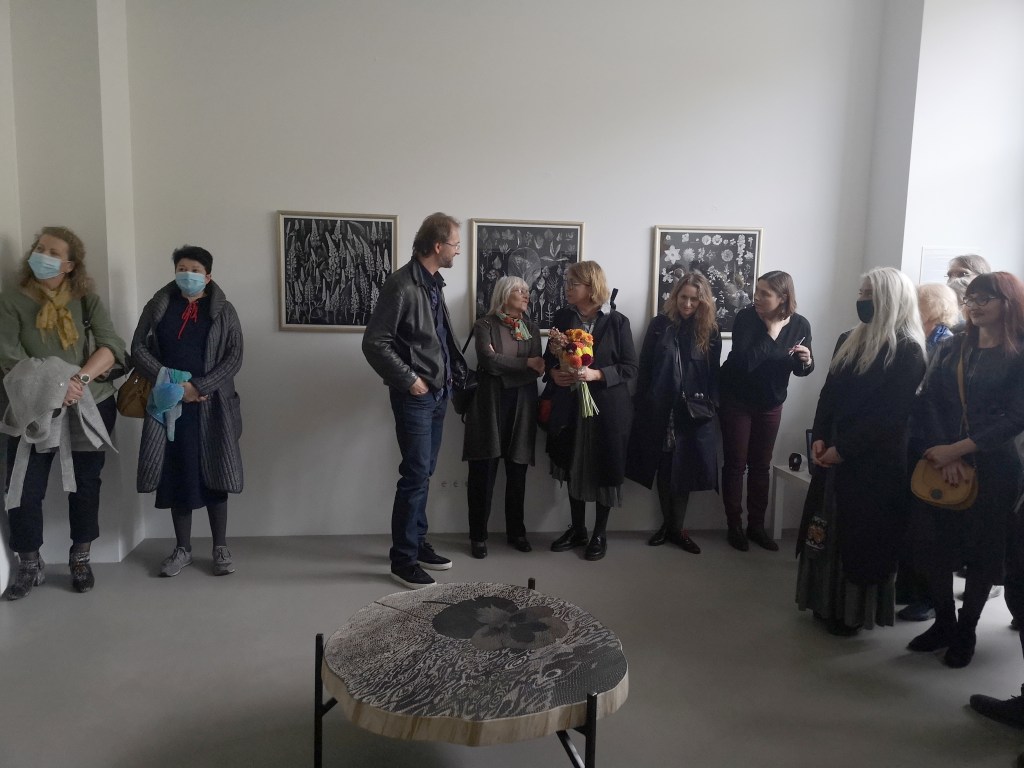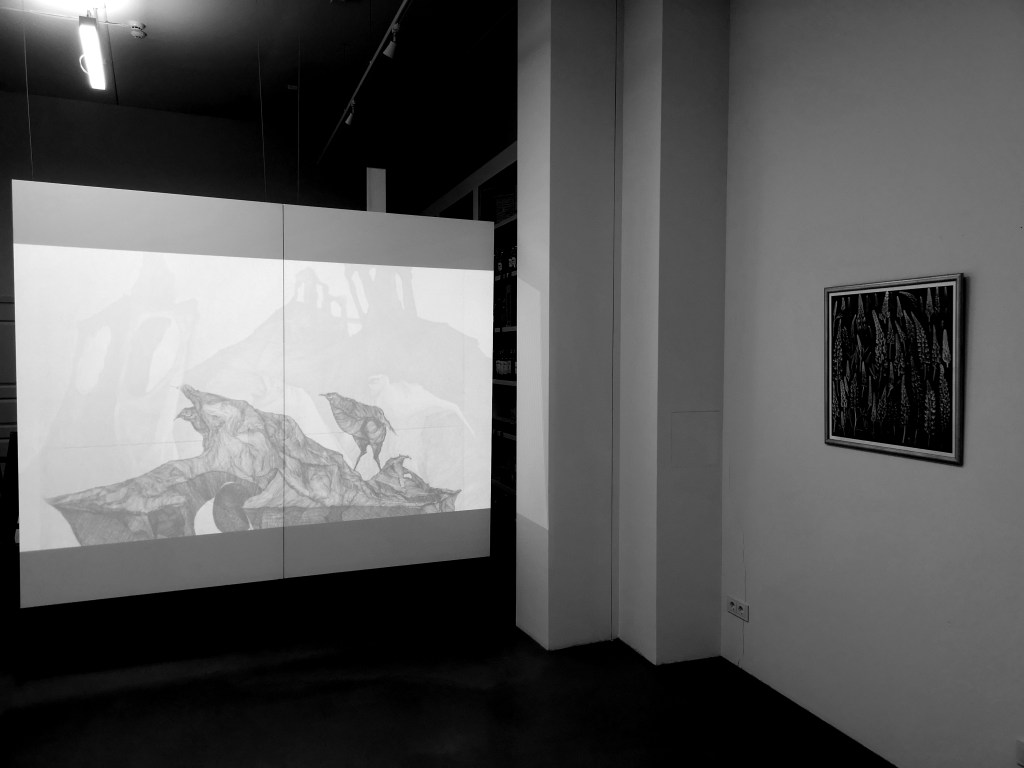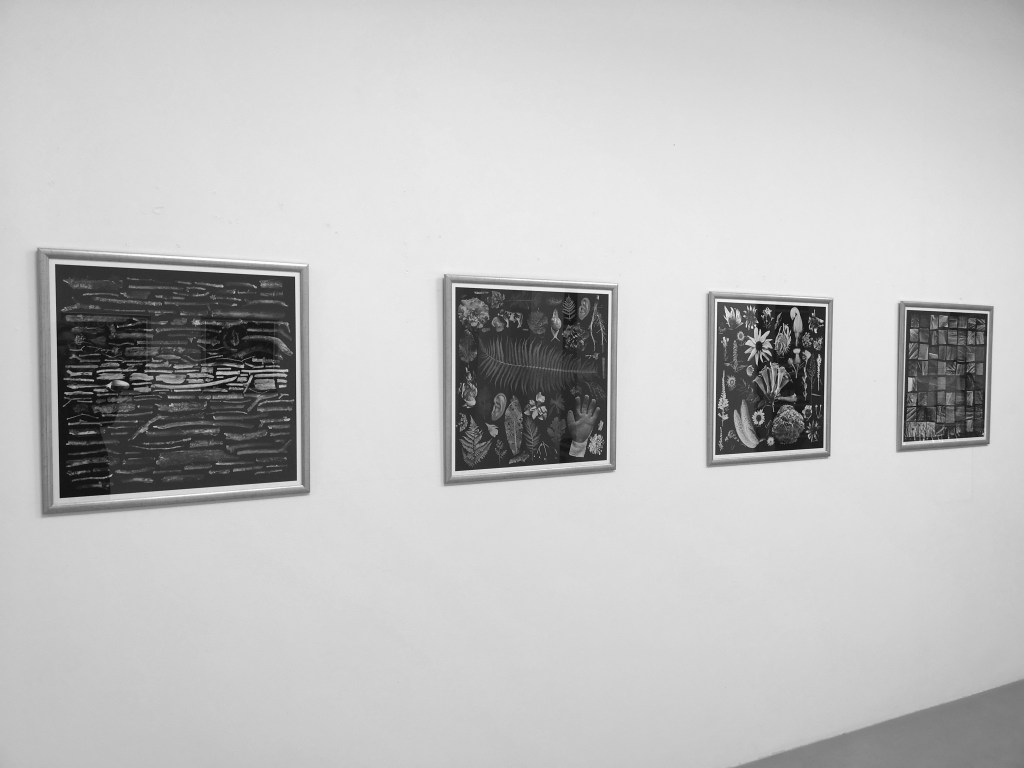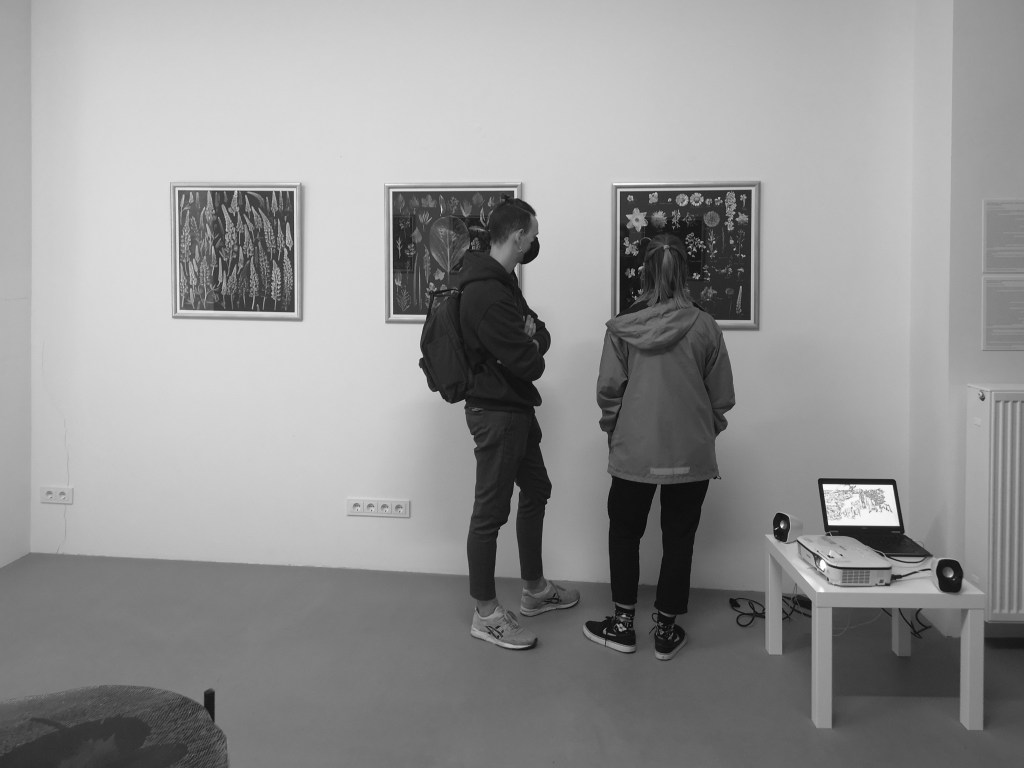for English please scroll down
Mamos mintys irgi privalo būti sutvarkytos
Projekto rėmėjas – LIETUVOS KULTŪROS TARYBA

XXa. 8-9 dešimtmečiais išgarsėjusi grafikė Alfreda Venslovaitė-Gintalienė, siurrealizmo krypties atstovė, vienintelė Lietuvoje akmens graviūros meistrė, šiandien gyvena atsiskyrusi kaime ir jau daugiau nei 20 metų neima į rankas pieštuko. Tačiau tik iš pirmo žvilgsnio atrodo, kad ji pabėgo nuo kūrybos. Su ta pačia aistra, kuria kadaise kasdien, po kelioliką valandų per dieną ji raižė metalą ir akmenį, šiandien, kartu su bendraautoriais gamta ir laiku, ji kuria savo paslaptingą sodą.
Ši moteris — mano mama.
Pagal išsilavinimą būdama menotyrininke ir psichologe, o pagal specialybę – fotografe, aš nusprendžiau, kad turiu visus reikalingus įrankius suprasti ir užfiksuoti mamos gyvenimo performansą.
Ilgą laiką mes, aš ir mano sesuo, žinoma šiuolaikinė grafikė Birutė Zokaitytė, pykome ant mamos, kad ji nustojo kurti. Pirkome ir vežėme jai piešimo priemones, įkalbinėjome ir priekaištavome. Kai 2014m. galerijoje ,,Kairė-Dešinė” įvyko personalinė mamos senų darbų paroda, apie ją rašė ,,7 meno dienos” bei ,,Artnews.lt”, o darbus įsigijo ,,MO” muziejus, tikėjomės, kad ji vėl sugrįš prie kūrybos, tačiau to nenutiko. Po parodos atidarymo mama nekantravo grįžti namo, bet ne piešti, o ravėti.
Bet niekada ji nebuvo buities žmogus. Visą vaikystę prisimenu, kad namuose amžinai būdavo chaosas, o mamai rūpėjo ne buitis, tik kūryba.
Negalėjome suprasti, kas jai nutiko. Kodėl ji kūrybą iškeitė į žemės darbus? Ar gali žmogus šitaip pasikeisti?
Mamos sodas toks keistas, jis nepanašus į jokį kitą. Nors ji pluša ten kasdien nuo ankstyvo ryto, tačiau sodas iš pirmo žvilgsnio primena chaotiškai augančius keistų augalų šabakštynus. Ten nėra tvarkingų spalvotų gėlių lysvių, nieko saldžiai dailaus, skirtingi augalai derinami grupėmis jai vienai suprantama tvarka, mamai patinka augalų formos, struktūros, masės ir ornamentai.
Mesti karjerą ir pabėgti į kaimą gyventi atsiskyrėlio gyvenimą yra tam tikra klišė, stereotipas, o galbūt – archetipinis būdas susitaikyti su tikromis ar įsivaizduojamomis nesėkmėmis, socialinių vertybių ir mąstymo paradigmų pokyčiais, laiko tėkme ir neišvengiamu gyvenimo baigtinumu.
Galbūt fotografuodama mamos sodą aš tiriu šį archetipą? – svarsčiau paėmusi į rankas kamerą.
Idėja apie tai, kad mamos sodas yra jos kūrybinio kelio dalis, kilo klausantis jos pasakojimų, dalyvaujant ,,ekskursijoje”, kurias prievarta veda kiekvieną kartą, kadangi, anot mamos, kasdien sodas keičiasi, ir to kas yra šiandien, jau nebepamatysi rytoj. Man sunku pamatyti sodą jos akimis, o ekskursijos sukelia kančią, nuobodulį, beprasmybės jausmą. Kur tas grožis? Šiuose keistų susipynusių augalų kuokštuose? Sudėtinguose lotyniškuose pavadinimuose? Žolelių vaistinėse savybėse? Kaip įmanoma visa tai prisiminti, o pamiršti, kuri šiandien diena?
Tačiau aš noriu suprasti, o ne nusivilti.
Kalbėdama apie sodą, ji visuomet dar pasakoja apie paukščius ir dangų. Saulę, mėnulį, debesis, apšvietimo kuriamą nuotaiką: ,,Pažiūrėk, lafantų viršūnės kaip kitos civilizacijos dangoraižių bokštai, o kokie debesys raudoni, Marso panorama…”. Mamos žvilgsnis nuo žemės, augalų nuolat nukrypsta į viršų. Ir pastebėjusi tai, suvedžiau paraleles su jos grafikos kūriniais. Augalais virstanti civilizacija, dangaus kūnai, paukščiai – pagrindiniai jos menotyrininkų pastebėtų ir įvertintų grafikos kūrinių motyvai.
Žiemai sodo dalis persikelia į vidų – kai kurie augalai negali žiemoti lauke, o kiti džiovinami, rūšiuojami, virsta arbatomis arba prieskoniais, bet daugiausia jų tiesiog uždengia visus namų paviršius, pripildo indus, susisuka į keistas formas, kaupia dulkes ir paverčia mamos namus erdve, kurioje gyventi nepatogu, mus tai varo iš proto, o jai svarbu, tik kad būtų kuo grožėtis.
Atsiribodama nuo išankstinių nuostatų mėginu suprasti, kaip sodą įprasmina mama, atrasti ryšį tarp sodo ir meno juodai baltuose fotomontažuose tvarkydama ir struktūruodama chaosą (kosmosą). Pasaulis, kurį patiria žmogus savo juslėmis atrodo chaotiškas, o menininkas jį sutvarko, surūšiuoja, ir žiūrovui perteikia tik esensiją, savo perspektyvą. Mama – kosmosas, aš tampu tvarkytoja. Lyg 19 a. pabaigoje gyvenęs mokslininkas ir menininkas Ernst Haeckel, kruopščiai rūšiuoju objektus. Objektai – mokslas. Pikseliai. Skaitmeninė fotografija. Meno kūrinys yra ne patys objektai, o ryšiai tarp jų. Rūšiuoju žiedus, lapus, pagaliukus, ir kitus čia randamus objektus į kolekcijas. Pirmos kolekcijos — logiški ir struktūruoti herbariumai su lotyniškais pavadinimais. ,,Teisingi” ryšiai tarp objektų sutvarko chaosą, teisingais ryšiais aš jam suteikiu prasmę. Tai nuramina.
Ilgainiui, žaidžiant toliau, ryšiai ima keistis.
Iš chaoso sėklos išauga siurrealizmo daigas. Ryšiai tarp objektų tampa išdykę. Jie simbolizuoja nebe mokslinį požiūrį ir tvarką, o psichologines būsenas. Susitaikymą, tariamumą, žaidimą, o kartais – beprotybės šmėklas.
Apie autorę
Agnė Gintalaitė yra tarpdisciplininė kūrėja – medijų menininkė, fotografė, iliustratorė ir tekstų rašytoja. Nuo 2015 m. Fotomenininkų sąjungos narė.
Svarbiausi kūriniai:
2015 metais jos sukurta Sovietinių garažų nuotraukų montažų serija ,,Beauty Remains” sulaukė tarptautinio susidomėjimo, apie projektą rašė daugiau nei pusšimtis internetinių ir popierinių kultūros leidinių visame pasaulyje.
2019 metais Agnė surengė personalinę parodą Vilniaus fotografijos galerijoje, kurioje pristatė projektą ,,Be perspektyvos” – dronu fotografuotų ir iš dalių sumontuotų Sovietinių gyvenamųjų namų nuotraukas.
Menininkės kūrybos bendras bruožas yra kolekcijų kūrimas, visumos dėliojimas iš detalių. Agnės kūrinys yra ne atskiros detalės, ir ne iš jų sudėliotas objektas, o prasmės, kurias sukuria ryšiai tarp atskirų kūrinio elementų.
Garažo duris jungė spalvinė dermė, kuri sukūrė naują prasmę miesto gėda vadintam Sovietiniam reliktui – grožį. Mandalų iš elektronikos atliekų efektas taip pat buvo estetinis, šiukšlių virtimo grožiu ir atsinaujinimo simboliu prasmė išreikšta reklamiškai aiškiai, tiesmukai skatinant žmones rūšiuoti elektronikos atliekas ir atiduoti jas perdirbimui.
Sovietinių daugiabuči nuotraukose perspektyvos nebuvimo faktas buvo sukurtas irgi dėl ryšio tarp atskirų mozaikos dalelių – tiesiai iš priekio, be perspektyvos fotografuotų atskirų namo segmentų. Namai ,,Be perspektyvos” pasakojo apie socialinį fenomeną – namus be perspektyvos, be ateities.
2020 metų projekte ,,Sodas ir kosmosas” ryšių tarp objektų prasmės tampa nebe taip aiškiai apibrėžtos, kintančios, juokaujančios ir pasakojančios istoriją.
Agnė Gintalaitė: ,,Man patinka galvoti apie tai, kad viskas — ir žmogus, ir stalas yra sudaryti iš tų pačių dalelių. Svarbios ne pačios dalelės, o ryšiai tarp jų. Ryšiai žmogų padaro žmogumi, o stalą – stalu.”




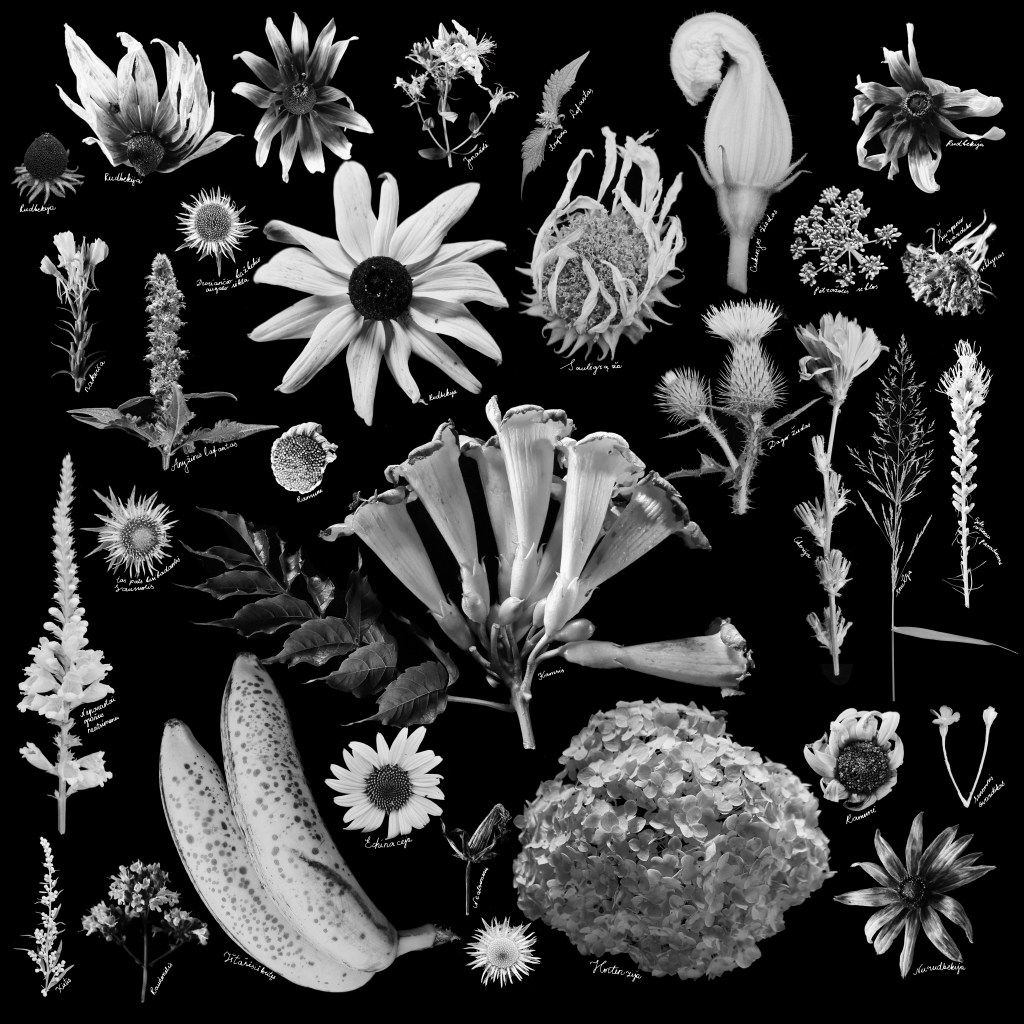

![]() Garden and Cosmos
Garden and Cosmos
My mother’s thoughts must also be sorted
Alfreda Venslovaitė-Gintalienė is the only graphic artist in Lithuania was to master the stone engraving technique. Her work, which stylistically is close to Surrealism, was mainly created in the late twentieth century. However, Alfreda Venslovaitė-Gintalienė has not held a pencil or a burin in more than 20 years. She lives a secluded life in a village. Even though at the first glance it might seem that she has given up art completely, this is not so: she is creating a mystery garden with the same passion she used to etch stone and metal for a dozen hours a day.
This woman is my mother.
Being trained in art history and psychology and having worked as a professional photographer, I realised that I have all the necessary tools to understand and capture this garden-making as a performance of my mother’s life.
For a long time, my sister Birutė Zokaitytė (who is also an acclaimed graphic artist) and I were upset that our mother stopped making art. We bought art supplies for her, tried to convince her to take up her creative work again and reproached her when nothing worked. In 2014, an exhibition of my mother’s old works opened in the print art gallery “Kairė-Dešinė”. It was reviewed in “7 meno dienos” and “Artnews.lt”. Some works were acquired by the “MO” museum. We were hoping that after this success she would return to the arts; however, this never happened. After the exhibition, mother was excited to return home, but to weed, not to sketch.
And yet doing daily chores was never her personality. When I was a child, my mother did not care about housework, she cared only about her art. Chaos reigned around the house.
We could not understand what happened to her. Why did she exchange artistic creation for digging soil in the garden? Can a person really change so much?
My mother’s garden is strange; it does not resemble any other garden. Even though she works there every day, from a distance the garden appears a chaotic mess of weird plants. There are no tidy, colourful flower beds, there is no sweet, neat beauty. Different plants are grouped in such a way that only she can make sense of it. Mother likes the forms, volume, structures and patterns of plants.
To abandon one’s profession and escape the city to live a hermit’s life is certainly a cliché; but also perhaps an archetypal way to come to terms with one’s real or perceived failures, changes in values and thinking. It is an attempt to accept the flow of time and the inevitable finitude of life.
Holding my camera in my hands I was wondering if it could be that by photographing my mother’s garden I am exploring this archetype.
The idea that mother’s garden is part of her creative trajectory crystallised when I was listening to her stories during a “guided tour“, a tour that I had to take repeatedly, because, according to my mother, the garden was changing every day. I struggle to see the garden the way she sees it. These tours frustrate and bore me. Where is the beauty? Is it in these strangely entangled plants? In the complicated Latin names? Or in the medicinal properties of herbs? How is it possible to remember all this information and, at the same time, to forget which day it is today?
In spite of this, I desire to understand what is happening.
When mother tells me about her garden, she also tells me about the sky and birds. She is describing the sun, the moon, and how the light creates a particular mood. Look at these Agastache foeniculum, they are like the skyscrapers of foreign civilisations, and these clouds, they are like clouds on Mars. Mother’s gaze strays from the earth to the skies. This made me think about her graphic prints, where the main motifs are civilizations that are morphing into plants, celestial bodies and birds: this was noticed and appreciated by critics.
In the winter, part of the garden moves inside the house: while some plants cannot survive the cold outdoors, others are dried, sorted, and turned into tea or spices. However, most of them simply cover all surfaces of the house, they fill vases and pots. They get entangled into strange piles, collecting dust and turn my mother’s house into a very uncomfortable, unlivable space. This drives us crazy. For her, it gives her something beautiful to look at.
I have tried to shed my preconceptions about what is a normal garden and a normal life. I am seeking to understand the way in which my mother makes sense of her garden. I am exploring the relation between the art and the garden by sorting the chaos – or cosmos – in my black and white photomontages. The world that is perceived by human senses can come across as chaotic. The artist sorts this chaos, transmitting to the viewer their own sense of order, a perspective. My mother is cosmos, I am the sorter. I am thinking about Ernst Haeckel, a nineteenth-century scientist, who drew fabulous collections of animate and inanimate objects. Like Haeckel, I am sorting the objects carefully, with a scientist’s passion, pixel by pixel. This is digital photography.
A work of art is not an object, but relations between objects. I am sorting blossoms, leaves, sticks and random objects that I found in my mother’s garden into collections. The first collection is a herbarium, which is logical and well structured, which contains plants’ names in Latin. “The correct” relations between objects sorts out the chaos, by imposing those correct relations I am giving meaning. This calms me down.
Eventually, as I continue playing with these strange objects, relations start to change.
Surrealism starts to sprout from chaos. Relations between objects become naughty: they no longer symbolize the scientific approach and order, but ephemeral psychological states. They suggest reconciliation, relativity, and playfulness. Sometimes they suggest the specter of madness.
………………..…
About the author
Agnė Gintalaitė develops an interdisciplinary practice as a media artist, photographer, illustrator and writer. Since 2015, she is a member of the Photographic Artists’ Union.
Key projects
„Beauty Remains“ (2015), a series of photo montages of dilapidated Soviet garage doors photo gained international interest and was presented and reviewed in many cultural publications.
„Without Perspective“ (2019), a personal exhibition of photographs of Soviet apartment blocks, made with a drone and assembled to create an impression of a perspective-less point of view, the Vilnius Photography Gallery.
Agnė Gintalaitė develops a technique of photo-collection, composing small pieces into a mosaic. Her practice explores the creation of new relations in aesthetic and meaning that emerge this process of assembling. For instance, the garage door project was organised to create a harmonious coloristic effect. The resulting effect of beauty changed public perception of the garage shanty towns, which were perceived as an embarassing urban space. Gintalaitė‘s other project, mandalas made of electronic waste items was based on a similar principle, where electronic waste was assembled into beautiful, regular systems, to encourage people to approach waste as a resource. The vision that was not distorted by perspective in the photographs of the Soviet apartment buildings was also achieved by assembling the blocks from individual pictures of panel blocs, shot taken straight from the front by the drone.
In Gintalaitė‘s new project, “Garden and Cosmos” (2020), the meanings and roles of relations between objects become less clearly defined. The objects are assembled in the ways that suggest change, humour and narratives. As Gintalaitė put it, “I like to think about the fact that everything, even a person and a table are composed of the same particles. It is not the particles themselves that are important, but the connections between them. It is the connections that make a person a person and a table a table. ”
